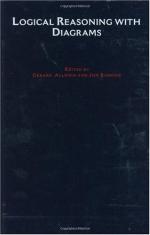|
This section contains 2,206 words (approx. 8 pages at 300 words per page) |

|
"Logic diagrams" are geometrical figures that are in some respect isomorphic with the structure of statements in a formal logic and therefore can be manipulated to solve problems in that logic. They are useful teaching devices for strengthening a student's intuitive grasp of logical structure, they can be used for checking results obtained by algebraic methods, and they provide elegant demonstrations of the close relation of logic to topology and set theory.
Leonhard Euler, the Swiss mathematician, was the first to make systematic use of a logic diagram. Circles had earlier been employed, by Gottfried Wilhelm Leibniz and others, to diagram syllogisms, but it was Euler who, in 1761, first explained in detail how circles could be manipulated for such purposes. Euler's contemporary Johann Heinrich Lambert, the German mathematician, in his Neues
 FIGURE 1
FIGURE 1Venn Diagram Applied to a Syllogism
Organon (1764) used straight lines, in a manner similar...
|
This section contains 2,206 words (approx. 8 pages at 300 words per page) |

|


